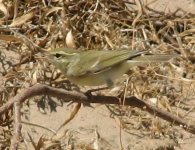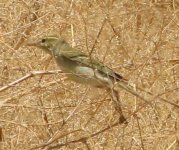-
Welcome to BirdForum, the internet's largest birding community with thousands of members from all over the world. The forums are dedicated to wild birds, birding, binoculars and equipment and all that goes with it.
Please register for an account to take part in the discussions in the forum, post your pictures in the gallery and more.
You are using an out of date browser. It may not display this or other websites correctly.
You should upgrade or use an alternative browser.
You should upgrade or use an alternative browser.
inornatus or trochiloides? (1 Viewer)
- Thread starter Askar Isabekov
- Start date
More options
Who Replied?gerdwichers8
Well-known member
Shalom
It may well be Phyoscopus nitidus, formerly regarded as a subspecies of trochiloides but for some years together with the complex trochiloides and plumbeitarsus, considered seperate species.
Inornatus is not in consideration here for most of its pale lower mandible, not strong contrasting dark dark centres to wing coverts and tertials, no white edges to tertials.
Nitidus is more green yellow to its upperparts than trochiloides, which is greyer.
Congratulations and thanks for sharing such nice bird.
Gerd
It may well be Phyoscopus nitidus, formerly regarded as a subspecies of trochiloides but for some years together with the complex trochiloides and plumbeitarsus, considered seperate species.
Inornatus is not in consideration here for most of its pale lower mandible, not strong contrasting dark dark centres to wing coverts and tertials, no white edges to tertials.
Nitidus is more green yellow to its upperparts than trochiloides, which is greyer.
Congratulations and thanks for sharing such nice bird.
Gerd
Mike Johnston
Well-known member
Definitely not Yellow-browed Warbler (inornatus). Most likely Greenish Warbler (trochiloides); don't think Green Warbler (nitidus) is found there; it's mainly between Black and Caspian Seas and migrates from there to S. India.
Last edited:
gerdwichers8
Well-known member
It so incredible yellow Mike; trochiloides is the most dull grey bird of the three..
Edit- May be first winter Greenish Warbler; I only saw adult summer viridanus (Greenish warbler)
The one Green Warbler I ever saw, was a first winter and much more yellow to underside than this bird.
:h?:
Edit- May be first winter Greenish Warbler; I only saw adult summer viridanus (Greenish warbler)
The one Green Warbler I ever saw, was a first winter and much more yellow to underside than this bird.
:h?:
Last edited:
Mike Johnston
Well-known member
First winter Arctic Warbler (borealis) might be the only other possibility, but I don't think so. Eye-stripe/lores would be darker, ear coverts blotchier, flanks not as clean. It could be nitidus - it just seems more likely to be a young trochiloides. Colour could be to do with the light and the yellowy vegetation.
Askar Isabekov
Well-known member
Thanks all. There are only two races of trochiloides in Kazakhstan. P.t. viridanus - common breeding migrant. B.t.plumbeitarsus - rare migrant. But viridanus breeds in Tien Shan Mountains and this birds were taken in desert zone over 100 km from mountains.
Askar
Askar
The Analog Kid
Formerly Net-falco
Mike Johnston said:First winter Arctic Warbler (borealis) might be the only other possibility, but I don't think so. Eye-stripe/lores would be darker, ear coverts blotchier, flanks not as clean. It could be nitidus - it just seems more likely to be a young trochiloides. Colour could be to do with the light and the yellowy vegetation.
Without looking replies borealis was first what came in my mind...
Last edited:
gerdwichers8
Well-known member
Me neither for borealis: the supercilium being narrow made me check it more carefully but especially that feature is good behind the eye: being typically broad. The lore is too thin for that. Leg colour may be difficult to decide but for what it is worth, it shows dark, not good for borealis and the projecting primaries can be seen well with care and its too short.
For plumbeitarsus may plead the slightly darker end of the cap, near the neck in this bird, but then again the greatercovertband is not wider for than its legs.
Its in between nitidus and the races of Greenish and geografically spoken, its probably one of the last ones. (but I find it yellow)
For plumbeitarsus may plead the slightly darker end of the cap, near the neck in this bird, but then again the greatercovertband is not wider for than its legs.
Its in between nitidus and the races of Greenish and geografically spoken, its probably one of the last ones. (but I find it yellow)
gerdwichers8
Well-known member
Note: Svensson reads for Green:"Judging from skins and a few photographs, supercilium apparently frequently does not reach nostrils as in the other races but finishes short, more like Ph borealis"
Which was actually the feature I struggled with, when sorting this borealis out.
May still not be conclusive though.
Which was actually the feature I struggled with, when sorting this borealis out.
May still not be conclusive though.
Last edited:
Askar Isabekov
Well-known member
Thanks
Jane Turner
Well-known member
Looks like a fairly standard 1st winter Greenish Warbler to me (viridanus).
Jane Turner
Well-known member
gerdwichers8 said:Note: Svensson reads for Green:"Judging from skins and a few photographs, supercilium apparently frequently does not reach nostrils as in the other races but finishes short, more like Ph borealis"
Which was actually the feature I struggled with, when sorting this borealis out.
May still not be conclusive though.
No need to look any further than the primary projection to rule out Arctic Warbler - they look more like Wood Warblers in that regard
http://orientalbirdimages.org/images/data/aw_db1.jpg
gerdwichers8
Well-known member
No, I dont hint for borealis itself, we had to sort out borealis because it was suggested a bit earlier on. And was found easy to distinguish on all keyfeatures except this particular noted one.
Svensson mentions it as an apparent feature between Green(which has the supercilium ending before reaching the nostrils (and it resembles borealis in this) and both Two-barred(plumbeitarsus) and Greenish(trochiloides), which have their supercilia reaching their nostrils and forehead.
Another subtle difference is the wingbar:
Broadest and equally broad tipped in plumbeitarsus, a bit less broad and less equal in nitidus and least in both regards in this feature in viridanus.
This again makes me think this is nitidus.
Svensson mentions it as an apparent feature between Green(which has the supercilium ending before reaching the nostrils (and it resembles borealis in this) and both Two-barred(plumbeitarsus) and Greenish(trochiloides), which have their supercilia reaching their nostrils and forehead.
Another subtle difference is the wingbar:
Broadest and equally broad tipped in plumbeitarsus, a bit less broad and less equal in nitidus and least in both regards in this feature in viridanus.
This again makes me think this is nitidus.
Askar Isabekov
Well-known member
Dear all.
There are no nitidus in Kazakhstan (Please see list of Kazakhstan Sylvidae http://www.birds.kz/index7.html#SYLVIIDAE ). This birds may be viridanus or plumbeitarsus only.
Like so it is plumbeitarsus .
Thanks all.
There are no nitidus in Kazakhstan (Please see list of Kazakhstan Sylvidae http://www.birds.kz/index7.html#SYLVIIDAE ). This birds may be viridanus or plumbeitarsus only.
Like so it is plumbeitarsus .
Thanks all.
Mike Johnston
Well-known member
Plumbeitarsus (Two-barred Greenish Warbler) would normally have a more strongly marked wing bar up to the scapulars, and a second wing bar on the median coverts.Askar Isabekov said:Dear all.
There are no nitidus in Kazakhstan (Please see list of Kazakhstan Sylvidae http://www.birds.kz/index7.html#SYLVIIDAE ). This birds may be viridanus or plumbeitarsus only.
Like so it is plumbeitarsus .
Thanks all.
While my practical experience of the Greenish complex is limited to a single 1st-winter viridanus here last September (and I have also only seen one Arctic Warbler), I would agree with Jane and state that this bird seems to be a viridanus Greenish.
Given the fresh condition of the plumage, the bird would have to be a 1st-w, as adults have a complete moult after arriving in the winter quarters (and would thus be quite worn around now). 1st-w plumbietarsus would show an obvious wingbar on the median coverts also, and 1st-w nitidus, were it even in contention, would surely be far more yellow-toned below? Arctic can be ruled out for reasons already discussed by others.
Regards,
Harry
Given the fresh condition of the plumage, the bird would have to be a 1st-w, as adults have a complete moult after arriving in the winter quarters (and would thus be quite worn around now). 1st-w plumbietarsus would show an obvious wingbar on the median coverts also, and 1st-w nitidus, were it even in contention, would surely be far more yellow-toned below? Arctic can be ruled out for reasons already discussed by others.
Regards,
Harry
MKinHK
Mike Kilburn

Mike Johnston said:Plumbeitarsus (Two-barred Greenish Warbler) would normally have a more strongly marked wing bar up to the scapulars, and a second wing bar on the median coverts.
Plumeitarsus occurs in winter in Hong Kong where it can show 0, 1 or 2 wingbars.
Not helpful, I know, but true!
gerdwichers8
Well-known member
Some features seem to contradict one another a bit.
One is the length of the supercilium: Longer in nitidus than viridanus. This supercilium would plead for nitidus.
The bordering with the cap is not good for nitidus. It shows less contrast. This bird even seems to have a darker colour in between the cap and the supercilium.
Next is the colour in front of the eye of the supercilium: brighter yellow in front of the eye than behind. This last one would rule out nitidus.
But then again, it is not so in the cap which shows a brighter yellow on the forehead in this bird than the back of the head
For the colour of the underparts, it needs not be yellow in all birds so there is overlap in first winter viridanus and worn adult nitidus.
If this bird definitely would be a first winter then its straightforward Greenish
One is the length of the supercilium: Longer in nitidus than viridanus. This supercilium would plead for nitidus.
The bordering with the cap is not good for nitidus. It shows less contrast. This bird even seems to have a darker colour in between the cap and the supercilium.
Next is the colour in front of the eye of the supercilium: brighter yellow in front of the eye than behind. This last one would rule out nitidus.
But then again, it is not so in the cap which shows a brighter yellow on the forehead in this bird than the back of the head
For the colour of the underparts, it needs not be yellow in all birds so there is overlap in first winter viridanus and worn adult nitidus.
If this bird definitely would be a first winter then its straightforward Greenish
Attachments
Last edited:
Edward woodwood
Member
it's a Greenish
Frenchy
Well-known member
The width of this birds wingbars does not rule out plumbeitarsus. I was recently (May)watching many of this race in China that had no median covert bar and a shorter, narrower greater covert bar. Indeed, some of them were probably indistuinguishable from viridanus. In one of the shots, the wingbar does seem to extend right accross the greater coverts, therefore favouring plumbeitarsus. However, from these two photos, it'd be a bold claim.
I agree with Tim, its a Greenish!!!
I agree with Tim, its a Greenish!!!
Users who are viewing this thread
Total: 2 (members: 0, guests: 2)






